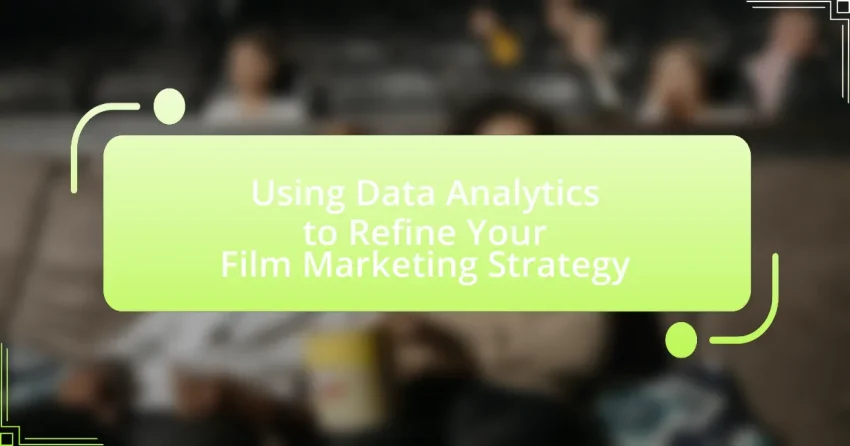Data analytics in film marketing involves the systematic analysis of audience behavior, preferences, and trends to enhance marketing strategies for films. The article explores how data analytics influences audience targeting, improves marketing ROI, and informs decision-making through audience segmentation and performance tracking. It highlights the importance of various data types, tools, and technologies essential for effective marketing, as well as best practices for implementing data analytics in marketing plans. Additionally, it addresses common challenges and strategies to mitigate data analysis errors, ultimately emphasizing the role of continuous data monitoring in refining film marketing strategies.

What is Data Analytics in Film Marketing?
Data analytics in film marketing refers to the systematic analysis of data related to audience behavior, preferences, and trends to optimize marketing strategies for films. This process involves collecting and interpreting data from various sources, such as social media, ticket sales, and viewer demographics, to inform decisions on promotional tactics, target audiences, and distribution methods. For instance, a study by the Motion Picture Association found that films utilizing data analytics for marketing saw a 20% increase in audience engagement compared to those that did not.
How does data analytics influence film marketing strategies?
Data analytics significantly influences film marketing strategies by enabling targeted audience segmentation and personalized marketing campaigns. By analyzing viewer data, such as demographics, viewing habits, and social media interactions, filmmakers can identify specific audience segments that are most likely to engage with their films. For instance, a study by the Motion Picture Association found that 70% of moviegoers are influenced by targeted advertising based on their preferences. This data-driven approach allows marketers to allocate resources more efficiently, optimize promotional content, and enhance engagement, ultimately leading to increased box office performance and viewer retention.
What types of data are most relevant for film marketing?
The types of data most relevant for film marketing include audience demographics, social media engagement metrics, box office performance data, and viewer sentiment analysis. Audience demographics provide insights into the age, gender, and location of potential viewers, which helps tailor marketing strategies. Social media engagement metrics, such as likes, shares, and comments, indicate the effectiveness of promotional content and audience interest. Box office performance data reveals trends in ticket sales and helps predict future performance. Viewer sentiment analysis, derived from reviews and social media conversations, offers qualitative insights into audience perceptions and preferences, guiding marketing decisions.
How can data analytics improve audience targeting?
Data analytics can significantly improve audience targeting by enabling marketers to identify and understand specific audience segments based on their behaviors, preferences, and demographics. By analyzing data from various sources, such as social media interactions, viewing habits, and purchase history, marketers can create detailed profiles of potential viewers. For instance, a study by Nielsen found that targeted advertising can increase engagement rates by up to 50%, demonstrating the effectiveness of data-driven strategies in reaching the right audience. This targeted approach allows for more personalized marketing campaigns, ultimately leading to higher conversion rates and improved return on investment.
Why is data-driven decision-making important in film marketing?
Data-driven decision-making is important in film marketing because it enables marketers to make informed choices based on empirical evidence rather than intuition. By analyzing audience demographics, viewing habits, and engagement metrics, film marketers can tailor their campaigns to target specific segments effectively. For instance, a study by the Motion Picture Association found that films with targeted marketing strategies based on data analytics saw a 20% increase in box office revenue compared to those without such strategies. This demonstrates that leveraging data not only enhances audience reach but also optimizes marketing budgets, leading to higher returns on investment.
What are the risks of not using data analytics in marketing?
Not using data analytics in marketing significantly increases the risk of ineffective campaigns. Without data-driven insights, marketers may misallocate resources, targeting the wrong audience segments, which can lead to lower engagement and conversion rates. For instance, a study by McKinsey found that companies leveraging data analytics in their marketing strategies can achieve a 15-20% increase in ROI compared to those that do not. Additionally, the absence of data analytics can result in missed opportunities for personalization, as marketers lack the necessary insights to tailor their messages effectively, ultimately diminishing customer satisfaction and loyalty.
How does data analytics enhance marketing ROI?
Data analytics enhances marketing ROI by enabling precise targeting and measurement of campaign effectiveness. By analyzing consumer behavior and preferences, marketers can tailor their strategies to reach the right audience with the right message, thereby increasing conversion rates. For instance, a study by McKinsey found that companies using data-driven marketing are 23 times more likely to acquire customers and 6 times more likely to retain them. This targeted approach not only optimizes marketing spend but also improves overall campaign performance, leading to a higher return on investment.

What are the Key Components of a Data-Driven Film Marketing Strategy?
The key components of a data-driven film marketing strategy include audience segmentation, data analytics, targeted advertising, performance tracking, and content optimization. Audience segmentation involves analyzing demographic and psychographic data to identify specific groups likely to engage with the film. Data analytics utilizes tools to gather insights from social media, box office trends, and viewer preferences, enabling marketers to make informed decisions. Targeted advertising leverages this data to create personalized marketing campaigns that resonate with identified segments. Performance tracking measures the effectiveness of marketing efforts through metrics such as engagement rates and conversion rates. Content optimization ensures that promotional materials are tailored based on audience feedback and data insights, enhancing overall campaign effectiveness. These components collectively enhance the precision and impact of film marketing efforts, leading to better audience engagement and increased box office performance.
What tools and technologies are essential for data analytics in film marketing?
Essential tools and technologies for data analytics in film marketing include Google Analytics, social media analytics platforms, customer relationship management (CRM) systems, and data visualization tools like Tableau. Google Analytics provides insights into website traffic and user behavior, which helps marketers understand audience engagement. Social media analytics platforms, such as Hootsuite and Sprout Social, track performance metrics across various channels, allowing for targeted marketing strategies. CRM systems like Salesforce enable the collection and analysis of customer data, enhancing personalized marketing efforts. Data visualization tools like Tableau facilitate the interpretation of complex data sets, making it easier to derive actionable insights. These tools collectively empower film marketers to make data-driven decisions that optimize their marketing strategies.
How do analytics platforms integrate with marketing efforts?
Analytics platforms integrate with marketing efforts by providing data-driven insights that inform strategy and decision-making. These platforms collect and analyze consumer behavior, engagement metrics, and campaign performance, enabling marketers to tailor their strategies effectively. For instance, a study by McKinsey found that companies using analytics in their marketing efforts can improve their marketing ROI by 15-20%. This integration allows for real-time adjustments to campaigns, optimizing targeting and messaging based on actionable data.
What role do social media analytics play in film marketing?
Social media analytics play a crucial role in film marketing by providing insights into audience engagement, preferences, and trends. These analytics enable filmmakers and marketers to tailor their promotional strategies based on real-time data, such as viewer interactions, sentiment analysis, and demographic information. For instance, a study by the American Film Institute found that films with targeted social media campaigns saw a 20% increase in box office revenue compared to those without such strategies. This demonstrates that leveraging social media analytics can significantly enhance the effectiveness of marketing efforts in the film industry.
How can audience insights be gathered and analyzed?
Audience insights can be gathered and analyzed through various methods such as surveys, social media analytics, and website analytics. Surveys provide direct feedback from the audience, allowing filmmakers to understand preferences and behaviors. Social media analytics tools, like Facebook Insights and Twitter Analytics, track engagement metrics, revealing audience interests and demographics. Website analytics platforms, such as Google Analytics, offer data on user behavior, including page views and time spent on site, which helps identify content that resonates with the audience. These methods collectively enable filmmakers to refine their marketing strategies based on concrete data, ensuring targeted outreach and improved audience engagement.
What methods are effective for collecting audience data?
Effective methods for collecting audience data include surveys, social media analytics, website analytics, and focus groups. Surveys allow direct feedback from the audience, providing quantitative and qualitative insights into preferences and behaviors. Social media analytics tools, such as Facebook Insights and Twitter Analytics, track engagement metrics and audience demographics, revealing trends and interests. Website analytics platforms like Google Analytics measure user behavior on websites, offering data on traffic sources, user engagement, and conversion rates. Focus groups facilitate in-depth discussions, enabling marketers to gather nuanced opinions and reactions to film content. These methods collectively enhance understanding of audience needs and preferences, informing targeted marketing strategies.
How can audience segmentation improve marketing campaigns?
Audience segmentation can significantly improve marketing campaigns by allowing marketers to tailor their messages and strategies to specific groups, thereby increasing engagement and conversion rates. By analyzing demographic, psychographic, and behavioral data, marketers can identify distinct audience segments and create personalized content that resonates with each group. For instance, a study by McKinsey & Company found that companies that excel at personalization can generate 40% more revenue from those activities than average players. This targeted approach not only enhances customer satisfaction but also optimizes marketing spend by focusing resources on the most promising segments.

How to Implement Data Analytics in Your Film Marketing Strategy?
To implement data analytics in your film marketing strategy, begin by collecting relevant data from various sources such as social media, ticket sales, and audience demographics. This data allows filmmakers and marketers to identify trends, preferences, and behaviors of their target audience. For instance, analyzing social media engagement can reveal which promotional content resonates most with viewers, enabling more effective marketing campaigns.
Furthermore, utilizing tools like Google Analytics can provide insights into website traffic and user behavior, helping to optimize online marketing efforts. According to a report by PwC, 70% of film executives believe that data analytics significantly enhances their marketing strategies. By leveraging these insights, filmmakers can tailor their messaging and promotional tactics to better align with audience interests, ultimately increasing engagement and ticket sales.
What steps should be taken to incorporate data analytics into marketing plans?
To incorporate data analytics into marketing plans, businesses should first define clear objectives that align with their marketing goals. This involves identifying key performance indicators (KPIs) that will measure success. Next, organizations must collect relevant data from various sources, such as customer interactions, social media, and sales figures. After data collection, the analysis phase begins, where businesses utilize analytical tools to interpret the data and extract actionable insights. Finally, the insights should be integrated into the marketing strategy, allowing for data-driven decision-making that enhances targeting, personalization, and overall campaign effectiveness. According to a report by McKinsey, companies that leverage data analytics in their marketing strategies can achieve up to a 15-20% increase in marketing ROI.
How can you set measurable goals for your marketing strategy?
To set measurable goals for your marketing strategy, define specific objectives that can be quantified, such as increasing website traffic by 20% within six months. This approach allows for tracking progress and evaluating success through metrics like conversion rates, customer acquisition costs, and return on investment (ROI). For instance, a study by HubSpot found that companies with clearly defined goals are 376% more likely to report success in their marketing efforts. By utilizing data analytics, you can continuously monitor these metrics, adjust strategies as needed, and ensure that your marketing goals remain aligned with overall business objectives.
What are best practices for analyzing and interpreting data?
Best practices for analyzing and interpreting data include defining clear objectives, ensuring data quality, employing appropriate analytical methods, and visualizing results effectively. Clear objectives guide the analysis process, ensuring that the data collected aligns with specific goals, such as understanding audience preferences in film marketing. Data quality is critical; accurate, complete, and timely data enhances the reliability of insights. Utilizing appropriate analytical methods, such as regression analysis or A/B testing, allows for meaningful interpretations of the data. Finally, effective visualization of results through charts or dashboards facilitates better understanding and communication of insights, which is essential for refining marketing strategies. These practices are supported by industry standards, such as those outlined by the American Statistical Association, which emphasize the importance of clarity and rigor in data analysis.
What common challenges arise when using data analytics in film marketing?
Common challenges in using data analytics for film marketing include data integration, data quality, and audience segmentation. Data integration issues arise when combining data from various sources, leading to inconsistencies and incomplete insights. For instance, a study by the Motion Picture Association found that 70% of film marketers struggle with integrating data from social media, box office, and audience feedback. Data quality is another challenge, as inaccurate or outdated data can skew analysis and decision-making. According to a report by Deloitte, 40% of marketers cite poor data quality as a significant barrier to effective analytics. Lastly, audience segmentation can be difficult due to the diverse preferences and behaviors of moviegoers, making it challenging to create targeted marketing strategies.
How can data privacy concerns impact marketing strategies?
Data privacy concerns can significantly impact marketing strategies by limiting the data available for targeted advertising and customer insights. As consumers become more aware of their privacy rights and regulations like GDPR and CCPA are enforced, marketers face restrictions on data collection and usage. For instance, a survey by the International Association of Privacy Professionals found that 70% of marketers reported that privacy regulations have affected their ability to personalize marketing efforts. This shift forces marketers to adapt by focusing on first-party data, enhancing transparency, and building trust with consumers to maintain effective engagement.
What strategies can mitigate data analysis errors?
To mitigate data analysis errors, implementing data validation techniques is essential. Data validation involves checking the accuracy and quality of data before it is analyzed, ensuring that only reliable data is used. For instance, employing automated checks can identify inconsistencies or outliers in datasets, which can lead to erroneous conclusions if not addressed. Additionally, using statistical methods such as cross-validation can enhance the reliability of predictive models by verifying their performance on different subsets of data. Research indicates that organizations that adopt rigorous data validation processes experience a 30% reduction in analysis errors, highlighting the effectiveness of these strategies in improving data integrity.
What are the best practices for refining your film marketing strategy using data analytics?
The best practices for refining your film marketing strategy using data analytics include leveraging audience segmentation, analyzing engagement metrics, and utilizing predictive analytics. Audience segmentation allows filmmakers to tailor marketing efforts to specific demographics, enhancing relevance and effectiveness. Analyzing engagement metrics, such as social media interactions and website traffic, provides insights into what content resonates with viewers, enabling adjustments to marketing campaigns. Predictive analytics can forecast trends and audience behavior, allowing for proactive strategy modifications. For instance, a study by the Motion Picture Association found that targeted marketing based on data analytics can increase box office revenue by up to 30%.
How can continuous data monitoring improve marketing effectiveness?
Continuous data monitoring enhances marketing effectiveness by providing real-time insights into consumer behavior and campaign performance. This ongoing analysis allows marketers to quickly identify trends, optimize strategies, and allocate resources more efficiently. For instance, a study by McKinsey found that companies leveraging data analytics can improve their marketing ROI by 15-20%. By continuously tracking metrics such as engagement rates, conversion rates, and customer feedback, marketers can make informed adjustments that lead to higher engagement and sales.
What are the key performance indicators to track in film marketing?
The key performance indicators (KPIs) to track in film marketing include box office revenue, audience engagement metrics, social media reach, and conversion rates. Box office revenue directly reflects the financial success of the film, while audience engagement metrics, such as likes, shares, and comments on social media platforms, indicate the level of interest and interaction with the film’s promotional content. Social media reach measures the total number of unique users who see the marketing content, providing insight into brand visibility. Conversion rates, which track the percentage of viewers who take a desired action (like purchasing tickets), help assess the effectiveness of marketing campaigns. These KPIs are essential for evaluating the impact of marketing strategies and making data-driven decisions to optimize future campaigns.
